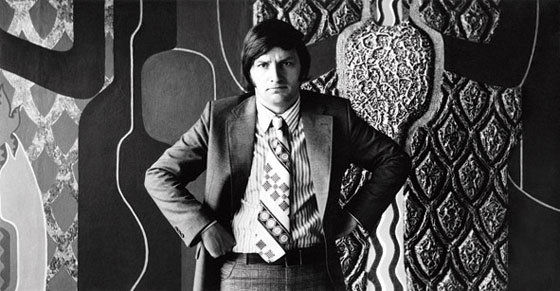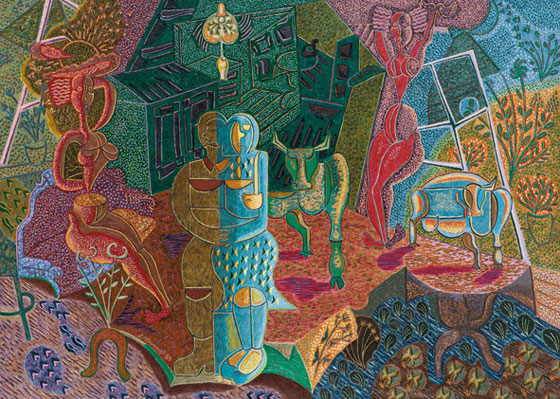|
|
| ...WHAT A TRUE PAINTER CAN DO Maija Tabaka Solo Exhibition of Leonīds Mauriņš at the White Hall of the Latvian National Museum of Art from 27 June to 27 July | |
 Leonīds Mauriņš | |
Is there another artist who can create a new colour palette for each painting, without ever repeating themselves? That is what Leonīds Mauriņš does, he and no-one else. His gift is such that it seems so easy and natural when evening colours flare up in purple supersonic vibration, or the sun brings in its heat in yellow hues, or when the water is blue enough to make you feel the crystal droplets of water in the air; these descriptions could go on and on, because his sensations are the first thing he shares. The further he goes in time, the easier it comes to him. It could seem that everything he does comes from God and is in the air around us, that there's not much to do because it exists all by itself - this great talent that comes from second-generation artists and that innate intelligence from people - Latvians - who lived before the war and all through Leonīds' childhood and his youth in the Soviet era. But how is it really? Is art there first, or does life determine and shape it? Why is there someone to whom everything is worthy of painting, and who creates those special things that only an artist can create? To him, the most important thing is to notice and work, and work, because all of it is wonderful, but it is also painful - putting colour with colour like that, a dot next to a dot, a line next to a line, until the painting may be enjoyed, until it has a velvety surface and the scent of roses, until beautiful girls arrive and are present everywhere, until the painting becomes radiant, it has an aura and a connection to the person looking at it. I no longer remember who it was that suggested the four of us put on an exhibition at the Jūrmala Exhibition Hall in 1975: Leonīds Mauriņš, Bruno Vasiļevskis, Gunta Liepiņa and Maija Tabaka. Leonīds was a star, his ideas were completely new, and Bruno Vasiļevskis (he controlled quality back then) praised the qualities of colour and rhythm in his works. It was decided that each of the artists had to be different, the ruling principle was variety. The exhibition drew much attention and also criticism, but at the same time it broadened the view of those who love art in Latvia. The exhibition was visited by Valdis Āboliņš, who came to Riga from West Berlin in search of the new trends in Latvian art. | |
 Leonīds Mauriņš. Portrait of a Family. 1980 | |
|
Leo has always been companionable; he was spinning like a top back then, when art was popular and, due to lack of subculture, very much in demand. But next to all this there was always something in progress on his easel, and ideas were piling up in sketches and drawings. He was always working. I don't really know what he was like in his private life, but whenever we met at a public event or on the streets of Riga it was always lovely to find that he had read so much, taken so much interest in society; he always expressed himself with such good humour and warmth. His paintings also radiate harmony and goodness. It is sometimes said that an artist must not be ill-natured and evil, that it will show in the paintings. Well, Leonīds was never like that; he can still say that he loves life and is no saint, but his true life and pleasure is put into his paintings. That is the true reality that he has created. There are people who say the countryside is boring, but then it seems they must be blind if nature does not smile upon them. Leo and Daina are often at their family home in Promulti, and in Leo's paintings I see that landscape, those people with their everyday joys and worries; these paintings are deeply Latvian. Our little fir trees, suns, birds, lindens, haystacks and that warm feeling that you get from seeing a cow that may have a bright green shadow, little old nanas and pops, and you can almost hear Leonīds Mauriņš's voice as he tells of his old, dearly loved aunt whom he took care of until her very last moments. Warmth and humanity shines from his every brush stroke. At the opening of the exhibition he said, "Do not look at me, look at my work." That is what we're doing, and that is where we see that he as a human being is never indifferent, that he is fair and honest; this is his link to a long heritage as a person of culture and to generation heredity. We also see an interest in other artists. Rarely do you get to see an artist who is still taking pleasure in the work of the Impressionists; he may give you a Manet album or gush over Renoir, or admit to the influences of Picasso and Braque in shaping him as an artist - except there is nothing of them left in him now, because this artist is himself, only his own self with his musicality and his newly discovered mandala, brought back form Kuala Lumpur. There are entire cycles of paintings devoted to the mandala, until it was again pushed out by Latvian rhythmics and the sound of water and also the presence of woman. This woman is now more real, more spirited and, in his 2008 work, more sensuous - these are fulfilled dreams. The colours are velvety, dazzling, intoxicating. So much has been painted, and even the part that has been given away and lost along the spirals of time still exists somewhere, but for us, Latvians, unfortunately, only as the work of an "unknown artist". So far Leonīds Mauriņš has had the upper hand, as he has been saving his popularity until today, having kept his paintings in his studio and in his circle of acquaintances, and his exhibition came at the right time to show people what a true painter can do. | |
| go back | |







